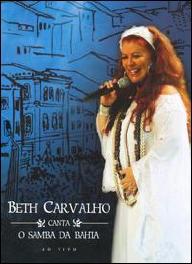Carvalho was born Elizabeth Santos Leal de Carvalho in the working-class suburb of Gamboa outside Rio de Janeiro but was raised in the middle-class South Side. At the age of seven, she was performing as a novice on several Carioca radio shows, like The Nacional. At the same time, she studied musical theory at the Escola Nacional de Música. With bossa nova bands playing informal venues like universities and schools, she took her initial musical steps in that style. Her first recording, for example, was the single "Por Quem Morrer de Amor" (Roberto Menescal/Ronaldo Bôscoli). She also performed another bossa nova with Tibério Gaspar, a popular musician and composer at the time, and in the bossa group Conjunto 3-D (Antônio Adolfo, piano, Chico Batera, drums, Luís, bass), singing with Eduardo Conde. At the same time, as evidenced by her infatuation for the typical samba of the hills, she performed in the A Hora E a Vez Do Samba show with Zé Keti and Os Cinco Crioulos.
In 1968, her interpretation of "Andança" (Danilo Caymmi/Edmundo Souto/Paulinho Tapajós) earned her third place at the III Festival Internacional da Canção. That success led to her first LP, Andança, which included the title song that became a classic of MPB and was re-recorded by many great singers like Maria Bethânia, Elis Regina, and Nana Caymmi. Her big turning point came in 1971, though, when she recorded the samba-enredo "Rio Grande Do Sul Na Festa Do Preto Forro" for the samba school Unidos de São Carlos. From then on, she dedicated herself to performing sambas, tightening her bonds with the hill culture. Her recording of "Só Quero Ver" (Edmundo Souto/Paulinho Tapajós) was a big hit and, excited to hear it sung in Salgueiro and Mangueira's rodas de samba, Carvalho decided that she would follow the in-your-face style of making music of the traditional communities of the hills. She moved to the Tapecar label as a samba singer, where she recorded the single "Amor, Amor" followed by the LP Canto Por Um Novo Dia, with samba icons like Geraldo Vespar, Nelson Cavaquinho (playing his unique violão in "Folhas Secas"), Luizão, Marçal, Luna, Eliseu, Martinho da Vila, and the group Nosso Samba. In 1974, the LP Pra Seu Governo also had Nelson Cavaquinho playing and singing, and she had a hit with "1800 Colinas" (Gracia do Salgueiro). The album sold very well in Brazil and was also released in France. Nos Botequins Da Vida (1977) sold 400,000 copies with the hits "Saco de Feijão" (Francisco Santana) and "Olho Por Olho" (Zé do Maranhão/Daniel Santos).
Since the late '70s, Carvalho, already established as a sambista, supported several young composers who later became famous in the samba and pagode idioms as the carriers of the torch, like Luiz Carlos da Vila, Jorge Aragão, Zeca Pagodinho, Almir Guineto, the group Fundo de Quintal, Arlindo Cruz, and Sombrinha, Moacyr Luz, and the Quinteto em Branco e Preto.
On 1978's De Pé No Chão, she presented Jorge Aragão playing the violão for her interpretation of his "Vou Festejar," which became a hit. 1979's Beth Carvalho No Pagode is considered a masterpiece, and featured her biggest hit of all time, "Coisinha Do Pai" (Jorge Aragão/Almir Guineto/Luiz Carlos). In the late '90s, the song was even sent to outer space in the space probe Pathfinder. The album also had several other hits, like "Pedi Ao Céu" (Almir Guineto/Luverci Ernesto) and "Tem Nada Não" (Almir Guineto/Luverci Ernesto/Jorge Aragão). The samba school Unidos do Cabuçu paid Carvalho homage, dedicating the samba-enredo "Beth Carvalho, a Enamorada Do Samba" (1984) to her.
As a composer, she wrote "Canção de Esperar Neném," included on Sentimento Brasileiro (1980). In 1987, she recorded Beth Carvalho Ao Vivo No Festival De Montreux live at the Montreux Festival in Switzerland. In the early '90s, she recorded another live album abroad, this time at the Olympia (Paris, France), Ao Vivo No Olympia. In 1999, Carvalho had another big national hit on the radio with "Samba de Arerê" (Xande de Pilares/Arlindo Cruz/Mauro Jr.), from the live CD Pagode De Mesa. A second volume appeared in the new millennium, and while it sold well, it didn't reach the commercial heights of its predecessor. In 2003 she released Canta Cartola via RCA, an entire album of songs by the founder of the Malgueira school, Agenor de Oliveira (aka "Cartola," 1908-1980). With its uncharacteristically sparse and subtle arrangements, it resonated with fans as a change of direction without leaving samba and MPB behind. The live Madrinha Do Samba followed in 2004, the first of three consecutive concert offerings that also included 40 Anos De Carreira: Ao Vivo No Theatro Municipal, Vol.1 (2006) and Canta O Samba Da Bahia (2007), before returning to the studio to issue Nosso Samba Ta Na Rua, featuring Zeca Pagodinho on the track "Arrasta A Sandália." Carvalho almost singlehandedly made Pagodinho a star in the '90s. She took part in the all-star concert celebration for 2012's Samba Na Veia 2 with fellow vocalist Jorge Aragão and Diogo Nogueira, and issued the live Ao Vivo No Parque Madureira two years later. ~ Alvaro Neder, Rovi


















